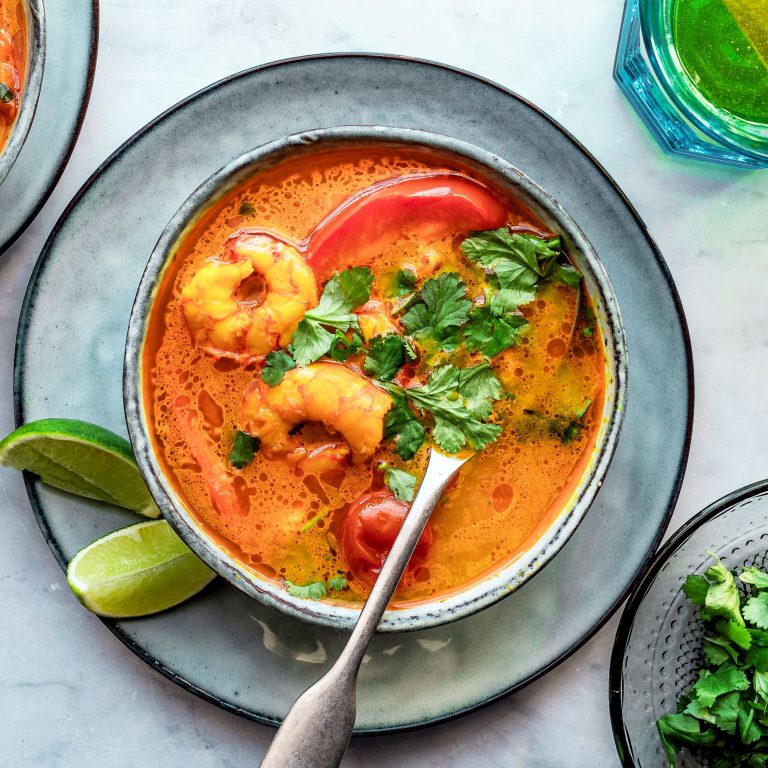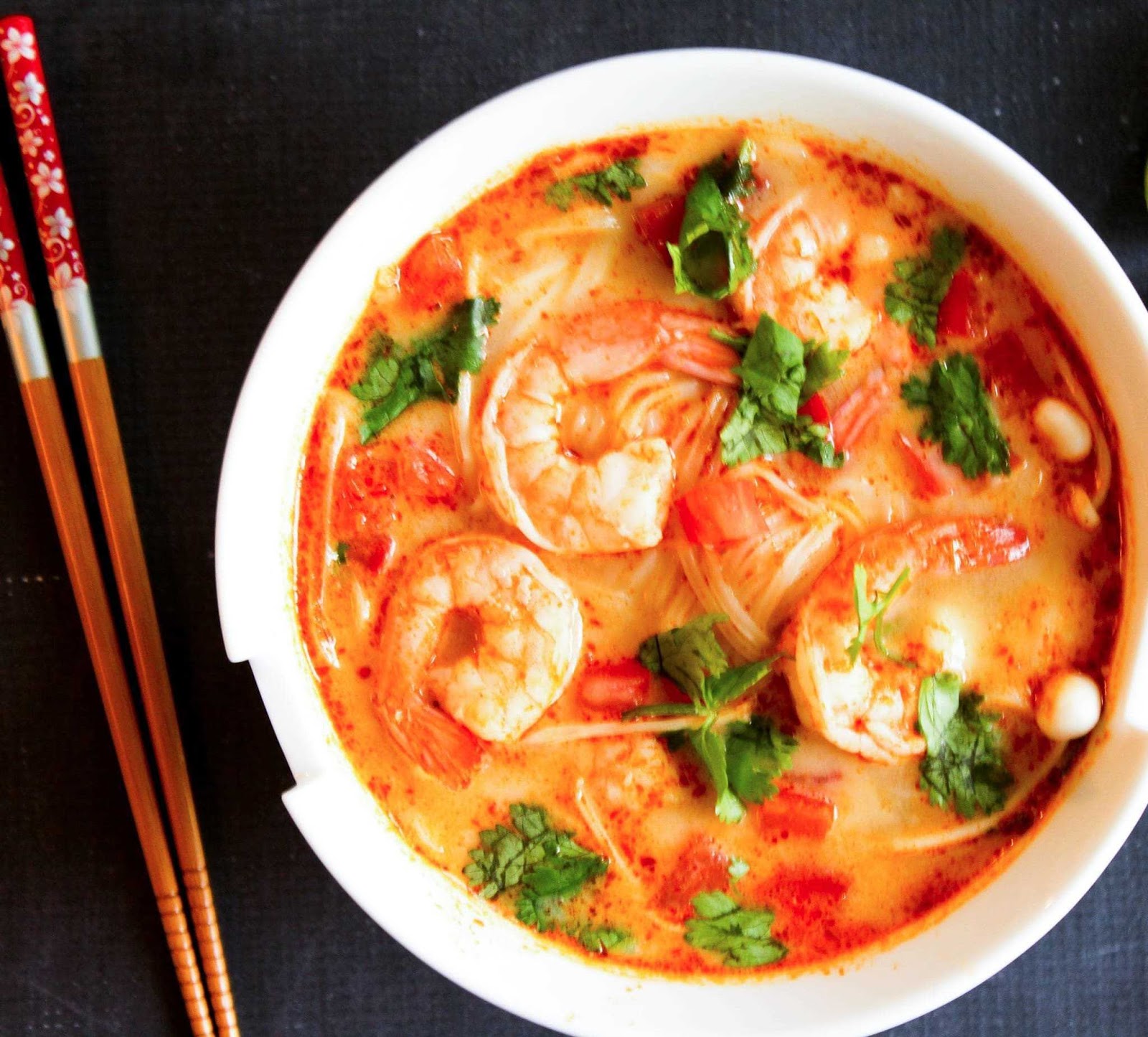Embark on a culinary adventure as we delve into the tantalizing world of authentic Thai Tom Yum soup. This iconic dish, deeply rooted in Thai culture, captivates taste buds with its symphony of flavors and aromas. Join us as we explore the intricacies of this beloved soup, uncovering its traditional ingredients, preparation techniques, and cultural significance.
From the vibrant markets of Bangkok to the serene temples of Chiang Mai, Tom Yum soup has woven its way into the fabric of Thai life. Its versatility extends beyond its taste, as it serves as a comforting elixir, a symbol of celebration, and a testament to Thailand’s rich culinary heritage.
Ingredients

Authentic Thai Tom Yum soup is renowned for its distinctive blend of spicy, sour, and umami flavors. The key to achieving this harmonious balance lies in using traditional ingredients that are fresh and of high quality.
The following ingredients are essential for crafting an authentic Tom Yum soup:
Main Ingredients
- Lemongrass: 3-4 stalks, cut into 2-inch pieces
- Kaffir lime leaves: 10-12 leaves, torn into pieces
- Galangal: 1 thumb-sized piece, sliced thinly
- Red chili peppers: 5-7, bruised
- Tomatoes: 3-4 medium, quartered
- Onion: 1 medium, sliced
- Mushrooms: 1 cup, sliced (optional)
- Shrimp: 1 pound, peeled and deveined (optional)
- Chicken broth: 4 cups
Seasonings
- Fish sauce: 3-4 tablespoons
- Lime juice: 2-3 tablespoons
- Palm sugar: 2-3 tablespoons (or granulated sugar)
- Salt: To taste
Garnishes
- Cilantro: 1/2 cup, chopped
- Thai basil: 1/2 cup, chopped
- Lime wedges: For serving
Preparation
Preparing Tom Yum soup is a straightforward process that involves creating a flavorful broth and adding fresh ingredients.
Begin by preparing the broth using lemongrass, galangal, kaffir lime leaves, and chili peppers. Simmer these ingredients in a pot of water until fragrant.
Adding the Ingredients
Once the broth is ready, add the remaining ingredients, such as mushrooms, tomatoes, and shrimp. Allow these ingredients to simmer gently until cooked through.
Cooking the Soup
Season the soup to taste with fish sauce, lime juice, and sugar. Bring the soup to a boil, then reduce heat and simmer for 10-15 minutes, or until the desired consistency is achieved.
Serve the soup hot, garnished with cilantro and additional lime wedges.
Variations
Tom Yum soup exhibits regional variations throughout Thailand, each with its unique blend of ingredients, flavors, and cooking methods.
These variations reflect the diverse culinary traditions and preferences of different regions. Some popular variations include:
Tom Yum Goong
- Prepared with fresh shrimp as the primary protein source.
- Typically features a clear, reddish-orange broth.
- Often includes additional ingredients such as lemongrass, galangal, and kaffir lime leaves.
Tom Yum Kai
- Uses chicken as the main protein.
- May have a slightly creamier broth due to the presence of coconut milk.
- Often incorporates ingredients like mushrooms, carrots, and bell peppers.
Serving and Presentation
Traditionally, Tom Yum soup is served hot in individual bowls or a large communal pot. The soup’s vibrant red color and aromatic steam create an enticing presentation.
Garnishes and accompaniments play a crucial role in enhancing the flavor and visual appeal of the soup. Cilantro leaves provide a refreshing herbal note, while lime wedges allow diners to adjust the acidity to their preference. Chili peppers add a fiery kick, adding both heat and a vibrant red hue to the soup.
Creative Presentations
- Garnish with edible flowers, such as Thai basil or chrysanthemum petals, for a delicate and elegant touch.
- Create a centerpiece by placing a large prawn or a few mussels in the center of the bowl, adding a touch of luxury and visual interest.
- Serve the soup in a hollowed-out coconut for an authentic and visually stunning presentation.
Health Benefits
Tom Yum soup is not only delicious but also packed with health benefits. The ingredients used in the soup are rich in antioxidants, vitamins, and minerals. These nutrients can help improve overall health and well-being.
Antioxidants
Tom Yum soup contains a variety of antioxidants, including lycopene, beta-carotene, and vitamin C. These antioxidants help protect cells from damage caused by free radicals. Free radicals are unstable molecules that can damage cells and lead to chronic diseases such as cancer and heart disease.
Vitamins
Tom Yum soup is a good source of vitamins, including vitamin A, vitamin C, and vitamin B12. Vitamin A is important for vision, skin health, and immune function. Vitamin C is a powerful antioxidant that helps protect cells from damage.
Vitamin B12 is essential for red blood cell production and nervous system function.
Minerals
Tom Yum soup is also a good source of minerals, including iron, calcium, and potassium. Iron is essential for red blood cell production. Calcium is important for bone health and muscle function. Potassium helps regulate blood pressure and fluid balance.
Cultural Significance
Tom Yum soup holds a profound cultural significance in Thailand, transcending its culinary appeal and becoming an integral part of the nation’s traditions and beliefs.
In traditional ceremonies and festivals, Tom Yum soup plays a central role. It is often served as an auspicious dish during weddings, representing the union of two families and the blending of flavors. The spicy and sour notes symbolize the balance between passion and harmony in a marriage.
Symbolism and Beliefs
Beyond its ceremonial significance, Tom Yum soup is also associated with certain beliefs and superstitions. The sourness of the broth is believed to ward off evil spirits, while the spiciness is said to bring good luck and prosperity.
In some parts of Thailand, it is believed that consuming Tom Yum soup on a rainy day can prevent illness. The hot and spicy broth is thought to warm the body and boost the immune system.
Recipe Table

To provide a comprehensive overview of the authentic Thai Tom Yum soup recipe, we have designed a concise HTML table that summarizes the key ingredients, quantities, and step-by-step instructions. This table is both responsive and mobile-friendly, ensuring accessibility and ease of use across various devices.
The table is structured with three primary columns: ingredients, quantities, and instructions. Each row represents a specific ingredient or step involved in preparing the soup. This format allows for quick and easy reference, making it convenient for home cooks and culinary enthusiasts alike to follow the recipe with precision.
Table Structure
The table is organized as follows:
- Ingredients Column: Lists the essential ingredients required to make the soup, such as lemongrass, galangal, kaffir lime leaves, and shrimp.
- Quantities Column: Specifies the precise measurements or amounts of each ingredient, ensuring accurate preparation.
- Instructions Column: Provides detailed step-by-step instructions, guiding the reader through the process of making the soup, from preparing the ingredients to simmering and serving.
Visual Illustrations
Visual illustrations play a crucial role in enhancing the understanding and appeal of the Tom Yum soup recipe. A series of high-quality images can guide the user through the cooking process, showcasing the ingredients, techniques, and final presentation.
Each image should be accompanied by detailed descriptions and captions that provide context and clarity. These illustrations can serve as a valuable resource for both experienced and novice cooks alike.
Ingredients Showcase
[Insert image of the various ingredients used in Tom Yum soup, such as lemongrass, galangal, kaffir lime leaves, chili peppers, and mushrooms.]
This image showcases the essential ingredients that give Tom Yum soup its unique and flavorful character. Each ingredient is clearly labeled, providing a visual representation of the recipe’s components.
Cooking Process
[Insert a sequence of images that demonstrate the step-by-step cooking process of Tom Yum soup.]
This series of images guides the user through the various stages of preparing the soup, from sautéing the aromatics to simmering the broth. Each image is accompanied by a caption that describes the specific technique or step being performed.
Final Presentation
[Insert an image of the finished Tom Yum soup, garnished with fresh cilantro and chili peppers.]
This image captures the vibrant colors and appetizing presentation of the completed dish. It showcases the vibrant red broth, tender seafood, and aromatic herbs that make Tom Yum soup a culinary delight.
Conclusion
Our exploration of authentic Thai Tom Yum soup concludes with a profound appreciation for its culinary artistry and cultural significance. This delectable dish not only satisfies the palate but also offers a glimpse into the heart of Thai cuisine. Whether enjoyed in a bustling street food stall or an elegant restaurant, Tom Yum soup remains an enduring testament to the vibrant flavors and traditions of Thailand.
Q&A
What is the origin of Tom Yum soup?
Tom Yum soup is believed to have originated in the Ayutthaya Kingdom in the 14th century. It is thought to have evolved from a sour and spicy soup called “tom pla,” which was made with fish and tamarind.
What are the key ingredients in Tom Yum soup?
The key ingredients in Tom Yum soup include lemongrass, galangal, kaffir lime leaves, chili peppers, and shrimp or chicken. These ingredients are simmered in a flavorful broth made from lemongrass, galangal, and kaffir lime leaves.
What are the different variations of Tom Yum soup?
There are many different variations of Tom Yum soup, each with its own unique flavor and ingredients. Some of the most popular variations include Tom Yum Goong (with shrimp), Tom Yum Kai (with chicken), and Tom Yum Po Taek (with mixed seafood).
